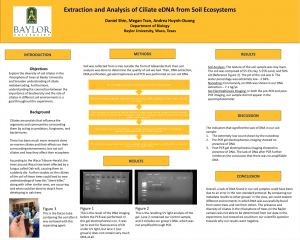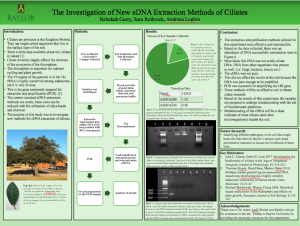Lab 14: Poster Presentation and Abstract Draft
April 26th, 2019
Rationale:
The purpose of this lab was to revise our poster presentations as well as write our abstract drafts.
Procedure:
- We began lab by editing our poster
- The conclusion section was elaborated upon
- The introduction was reorganized and shortened
- A few of the figures were deleted and reconfigured
- Next, the abstract draft was written and submitted
Observations/Data:
Final Poster:
Abstract:
There are many standard methods for extracting Ciliate eDNA but not all are effective and cost efficient.
Ciliates are protozoa in the Kingdom Protista. They play many different roles within soil and aquatic ecosystems. There has been very little research done on ciliate behavior and interactions within the soil. Our study targeted ciliates within the rhizosphere. The rhizosphere plays a key role in the cycling of nutrients as well as plant growth. Ciliates shape the diversity of microorganisms within the rhizosphere, thus their presence is vital to a healthy ecosystem.
The purpose of this study was to investigate new methods for eDNA extraction of ciliates.
Creating this new method was achieved by researching different ways to extract eDNA. These different methods were then combined to maximize the amount of eDNA collected. Metadata was collected regarding the soil sample and the environment it was collected from. Gels were run to determine the amount of DNA collected. The samples that contained an abundance of DNA underwent PCR in order to amplify the strand so they could more easily be sequenced.
The samples were loamy sand, with a pH of 6.5. The concentration of DNA in the sample was 1125 ng/ul and the A260/A280 value was 1.33. The DNA sequenced not only belonged to ciliate species, but fungal and bacterial species as well.
These results gave reason to believe the use of charcoal and Silica beads was effective in the extraction of DNA.
Conclusion:
Our posters are ready to be presented. In order to explain our experiment, it is important that as a group we review our procedures and findings. We must understand our work completely so that we are able to communicate clearly with listeners the importance of our research.








